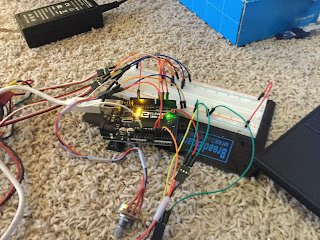Today, I write this post with great
joy (and a little bit of haste; things may be slightly unrefined),
for I have tested my Triwheel theory and proven my hypothesis
correct. For those of you who have not read my previous articles on
this, I suggest you do (post 1, post 2) before reading this one, but
if you are too lazy to do that, I will sum up what has been going on
up to now.
 |
| An image of the triwheel cage |
When I first started, I had a crazy
idea about flywheel cages. I thought, "what if there was a 3
flywheeled cage? What could be the potential of this?" I voiced
my theory publicly (mainly on Nerf forums and similar spaces) and got
slightly intriguing results (and mostly people just noting the
impracticality and ugly form factor). One user, in particular,
recommended the cage's use on rival rounds, and noticing the
potential, I set right away to work. The 3 wheeled system is useful
for this application because it allows for control of the Magnus
effect (explained more deeply in one of the other posts, read it) to
arc the HIR in the desired direction.
In no time, I produced a cage and
occompanying wheels sutable for HIRs. I soon after invented an
algorithm for determining wheel speed based on user input (it is
designed for a 2 potentiometer Videogame-styled joystick). I then
optimized this code for actual usage with the motors and
potentiometers (the original code can be found in one of the other
posts, and it is the algorithm only with a serial-based interface).
Testing was slightly challenging, as
the cage has to be held up by something instead of sitting on an
actual surface, but after I propped it up, I tried several coordinate
positions and pushed some HIRs onto one end. To my delight, the balls
curved in the direction of the set coordinates. I was attempting this
test with the motors at a very low speed indoors, and to see the
controlled hop-up work as effectively as it did brought me much joy.
Images:
 |
| this serial feed allows me to see what position the potentiometers are in while testing |
 |
| as of now, how I am controlling this setup |
 |
| a look down the center of the cage |
 |
| a ball in the cage |
 |
| another shot of the completed unit |
Expect to see a fully functioning
blaster come from this later.
Bare cage files on Thingiverse and
Github along with updated (still being refined, mind you) firmware.
This is awesome! Do you have a video of it in action yet?
ReplyDeleteAlso, what do you envision a blaster with this setup looking like as far as controlling the rival direction while firing?
ReplyDeleteI was thinking you could have one 360 degree pot specify the angle out of the barrel and a second pot determine the strength of the effect.
Sorry for the late reply. To answer your question, I actually have started work on a blaster that uses this system. In fact, it is almost finished being designed and is nearing the print cycle. (a little spoiler, I have unofficially nicknamed it the "turbine" for its rounded tank-like styling)
DeleteAs for the method of control, there are three adjuster potentiometers on the side. One for overall flywheel speed, one for fire rate, and one for length per trigger pull (similar to burst fire). The actual effect is controlled by a videogame joystick mounted on the top of the handle.
Good idea!But I think that use hop-up shuold be simple and batter
ReplyDelete